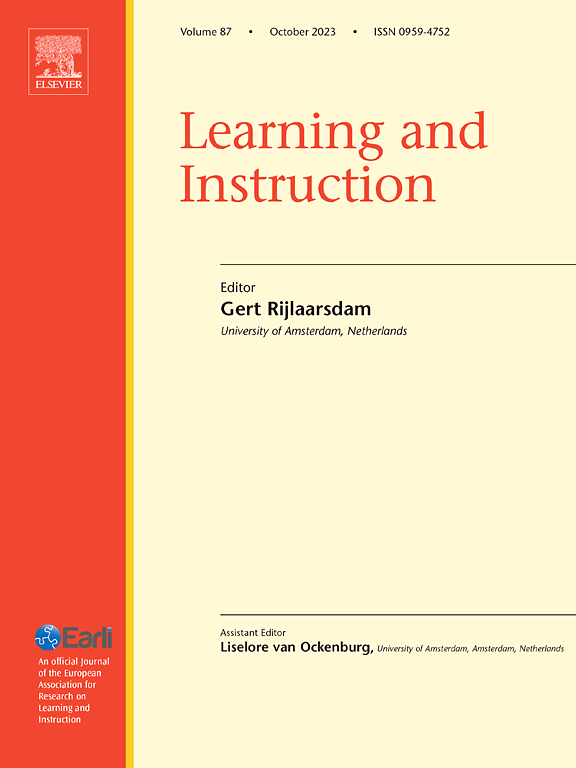Beyond analysing frequencies: Exploring teacher professional vision with epistemic network analysis of teachers’ think-aloud data
IF 4.9
1区 教育学
Q1 EDUCATION & EDUCATIONAL RESEARCH
引用次数: 0
Abstract
Background
Teacher professional vision describes how teachers perceive classroom events, interpret these events, and form decisions about next strategies. As indicators of visual expertise, noticing, and reasoning, analyses of think-aloud protocols can offer useful insights into novice and expert teachers’ mental models of observed classroom management events.
Aims
Informed by the cognitive theory of visual expertise, the study compared two methods—a standard frequency-based approach and epistemic network analysis (ENA)—for analysing think-aloud data from novice and expert teachers. The aim was to illustrate the potential of both methods in revealing how teachers integrate noticed visual information and classroom management scripts into elaborate mental representations of classroom management events.
Sample
Participants were 19 pre-service and 20 in-service teachers.
Methods
Teachers’ think-aloud data after watching a video with critical classroom management events were coded and analysed using a standard frequency-based approach and epistemic network analysis.
Results
The frequency-based approach counted the number of codes, indicating that experts verbalized student learning, teacher behavioural management, and alternative management strategies more frequently than novices. In comparison, ENA visualized the temporal co-occurrences of codes within event-related utterances, indicating that novices struggled to make sense of events while experts were able to integrate information and scripts into more elaborate and well-structured mental models.
Conclusions
When compared to a frequency-based approach, ENA can provide deep insights into teachers' mental representations of classroom management events. ENA is thus a useful novel method to examine teachers’ integration of information into mental models as indicators of professional vision and expertise.
超越频率分析:用教师有声思维数据的认知网络分析探索教师专业视野
教师专业视野描述了教师如何感知课堂事件,解释这些事件,并形成关于下一步策略的决策。作为视觉专长、注意和推理的指标,对有声思维协议的分析可以为观察到的课堂管理事件的新手和专家教师的心理模型提供有用的见解。在视觉专业知识认知理论的指导下,该研究比较了两种方法——标准的基于频率的方法和认知网络分析(ENA)——用于分析来自新手和专家教师的有声思维数据。目的是说明两种方法的潜力,揭示教师如何将注意到的视觉信息和课堂管理脚本整合到课堂管理事件的精心心理表征中。样本参与者为19名职前教师和20名在职教师。方法采用基于频率的标准方法和认知网络分析方法,对教师观看课堂管理关键事件视频后的有声思维数据进行编码和分析。结果基于频率的方法统计了代码的数量,表明专家比新手更频繁地使用学生学习、教师行为管理和替代管理策略。相比之下,ENA可视化了事件相关话语中代码的时间共现,表明新手很难理解事件,而专家则能够将信息和脚本整合到更复杂、结构更完善的心智模型中。与基于频率的方法相比,ENA可以深入了解教师对课堂管理事件的心理表征。因此,ENA是一种有用的新方法,可以检验教师将信息整合到心理模型中,作为专业愿景和专业知识的指标。
本文章由计算机程序翻译,如有差异,请以英文原文为准。
求助全文
约1分钟内获得全文
求助全文
来源期刊

Learning and Instruction
Multiple-
CiteScore
11.30
自引率
4.80%
发文量
109
期刊介绍:
As an international, multi-disciplinary, peer-refereed journal, Learning and Instruction provides a platform for the publication of the most advanced scientific research in the areas of learning, development, instruction and teaching. The journal welcomes original empirical investigations. The papers may represent a variety of theoretical perspectives and different methodological approaches. They may refer to any age level, from infants to adults and to a diversity of learning and instructional settings, from laboratory experiments to field studies. The major criteria in the review and the selection process concern the significance of the contribution to the area of learning and instruction, and the rigor of the study.
 求助内容:
求助内容: 应助结果提醒方式:
应助结果提醒方式:


